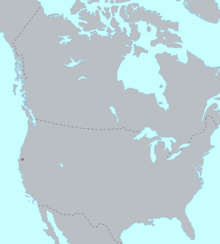Chimariko language
| Chimariko | |
|---|---|
| Native to | USA |
| Region | California |
| Ethnicity | Chimariko |
| Extinct | 1950s, with the death of Martha Zigler |
|
Hokan?
|
|
| Language codes | |
| ISO 639-3 | |
| Glottolog | chim1301 |

Pre-contact distribution of Chimariko
|
|
Chimariko is an extinct language isolate formerly spoken in northern Trinity County, California, by the inhabitants of several independent communities. While the total area claimed by these communities was remarkably small, Golla (2011:87–89) believes there is evidence that three local dialects were recognized: Trinity River Chimariko, spoken along the Trinity River from the mouth of South Fork at Salyer as far upstream as Big Bar, with a principal village at Burnt Ranch; South Fork Chimariko, spoken around the junction of South Fork and Hayfork Creek, with a principal village at Hyampom; and New River Chimariko, spoken along New River on the southern slopes of the Trinity Alps, with a principal village at Denny.
Proposals linking Chimariko to other languages in various versions of the hypothetical Hokan family have been advanced. Roland Dixon suggested a relationship between Chimariko and the Shastan and Palaihnihan families. Edward Sapir's famous 1929 classification grouped Chimariko with Shastan, Palaihnihan, Pomoan, and the Karuk and Yana languages in a Hokan sub-grouping known as Northern Hokan. A Kahi family consisting of Chimariko, Shastan, Palaihnihan, and Karuk has been suggested (appearing also within Sapir's 1929 Northern Hokan). Most specialists currently find these relationships to be undemonstrated, and consider Chimariko to remain best considered an isolate.
...
Wikipedia
